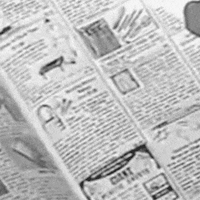
(The Blowup/Unsplash)
If you ask me, the original sin of internet advertising was tying it so closely and prominently to specific results.
Advertisers gained a level of data and nuance around advertising that broadcasting or print didn’t offer, all the while paying less for it than they did for print. It was a problem of pricing, one where early online publishers gave away the golden goose without even realizing what they had.
In some ways, the innovation has been amazing for smaller advertisers, but it has allowed advertisers to promote things based on the content, rather than the publication. And honestly, that broke the advertising system for traditional news.
For a quarter century, we have basically created a market driven by advertisers. And that has created all sorts of problems that we’ve yet to properly solve, including the active monetization of misinformation, a level of clutter that makes many modern websites unusable, and tracking that is truly at a level of depth and concern that it is clear regulation of this market is necessary.
But I’d like to take a step back and look at an even deeper problem the digital advertising era has created—the problem of brand safety concerns being attached to traditional news stories. With advertisers tied to the messages on the articles they promote—because they now work in more granular ways than simply slapping an ad on a facing page—they’re freaked out about the potential that an offensive message might be connected to them.
Now, to be clear, brand safety is not just a problem of internet-based advertising:
https://twitter.com/JetsGuy6/status/1496871231945154564
But it is a very serious problem, and it becomes particularly bad when a big news story occurs—such as COVID-19, or what’s happening in Ukraine right now—and brands, likely afraid of having their brand associated with something so negative, literally have the ability to shut off ads on certain keywords.
And lo and behold, that’s exactly what is happening right now with Ukraine, as a recent Business Insider report noted.
One advertising executive, John Lods of the advertising agency Arm Candy, said this:
We are excluding news in general. Almost all the sentiment around that category is negative. When's the last time you read a positive headline?
This is the advertising equivalent of starving a growing plant of water and nutrients when they’re needed the most. As a society, we need to make it as dangerous to do this as it is to blindly sponsor misinformation, because it in many ways is more offensive than a momentary bad association. They’re threatening journalism at the point where its resources must expand to support the moment.
https://twitter.com/ShortFormErnie/status/1498632015079526403
And it seems like something that advertisers, not just publishers, need to be willing to shift on to help solve. (Claire Atkin and Nandini Jammi, this would be a great extension of your current work.)
My recommendation would be that the ad industry work on designing an industry-standard underwriting approach to large news stories that is designed around separation and in-kind advertising that allows them access to free backfill advertising later on, but makes it clear that they are taking the moment to support journalism, because it’s the responsible thing to do. Think of it as a “big story mode” that only kicks in when a major story happens, and is available only to pre-vetted news sites. Maybe it looks like a bar on the bottom of the screen that highlights that the content is being underwritten.
Newspapers and online websites are unfortunately not in the position to turn away ad dollars in the way that advertisers can news stories—so they aren’t in a position to protest these moves by short-sighted, arguably greedy, advertisers. But it would sure be nice if they had an alternative to the status quo that actually makes sense for everyone.
Change the discussion from brand safety into brand support. That is significantly more productive than what we’re doing now.
Time limit given ⏲: 30 minutes
Time left on clock ⏲: alarm goes off



